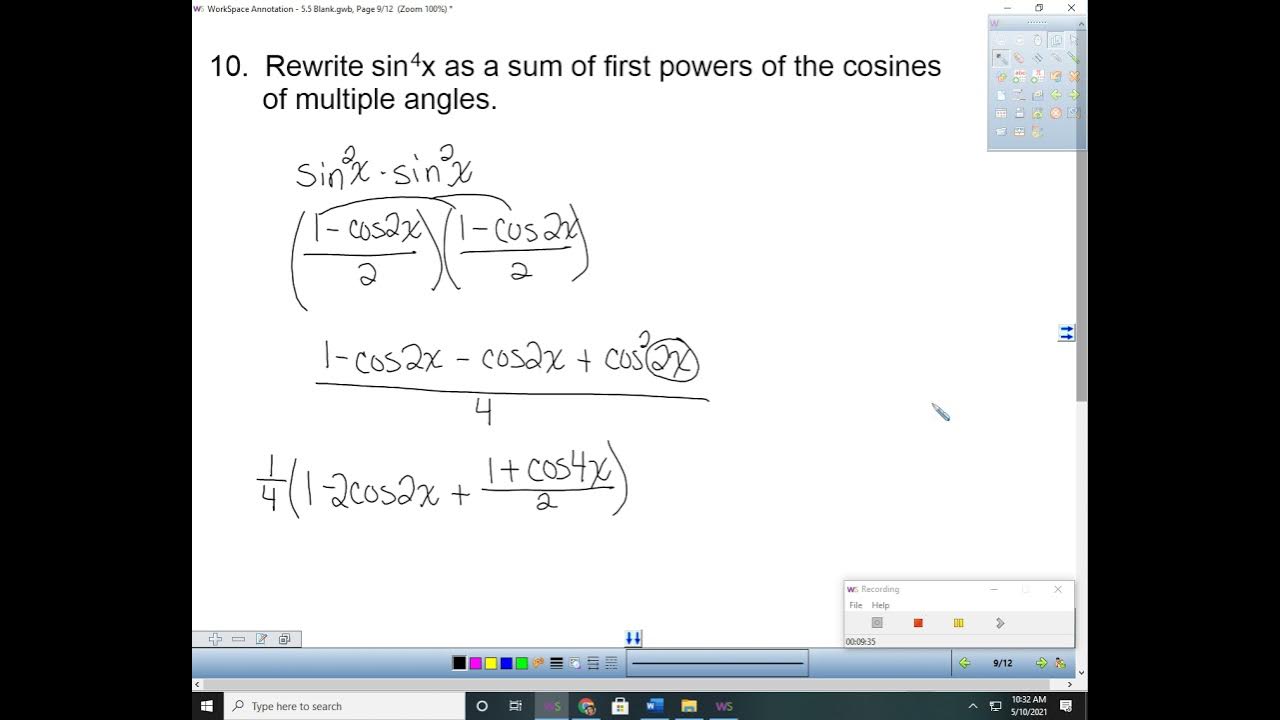Half Angle Formulas & Identities - Evaluating Trigonometric Expressions
TLDRThis educational video script delves into the derivation and application of half-angle trigonometric formulas. It begins by deriving the half-angle formula for sine from the power-reducing formula, followed by similar derivations for cosine and tangent. The script then applies these formulas to calculate the exact values of cosine 15 degrees, sine 22.5 degrees, and tangent 75 degrees, providing step-by-step instructions and simplification techniques. The video also compares decimal values obtained from a calculator to the derived results, ensuring understanding and reinforcing the concepts.
Takeaways
- 📐 The power reducing formula for sine squared is \( \sin^2(\theta) = \frac{1 - \cos(2\theta)}{2} \).
- 📝 By dividing the angle by 2 and taking the square root, the half-angle formula for sine is \( \sin\left(\frac{\theta}{2}\right) = \pm \sqrt{\frac{1 - \cos(\theta)}{2}} \).
- 📉 The power reducing formula for cosine squared is \( \cos^2(\theta) = \frac{1 + \cos(2\theta)}{2} \).
- 🔍 Similarly, the half-angle formula for cosine is \( \cos\left(\frac{\theta}{2}\right) = \pm \sqrt{\frac{1 + \cos(\theta)}{2}} \).
- 🔄 The half-angle formula for tangent is \( \tan\left(\frac{\theta}{2}\right) = \pm \sqrt{\frac{1 - \cos(\theta)}{1 + \cos(\theta)}} \).
- 🔢 Tangent's half-angle formula can also be expressed as \( \tan\left(\frac{\theta}{2}\right) = \frac{1 - \cos(\theta)}{\sin(\theta)} \) or \( \tan\left(\frac{\theta}{2}\right) = \frac{\sin(\theta)}{1 + \cos(\theta)} \).
- ✅ Using the half-angle formula, \( \cos(15^\circ) = \sqrt{\frac{2 + \sqrt{3}}{2}} \) because cosine is positive in the first quadrant.
- 📊 To confirm, \( \cos(15^\circ) \) can also be evaluated using a calculator to get approximately 0.9659.
- 🎯 The exact value of \( \sin(22.5^\circ) \) is \( \sqrt{\frac{2 - \sqrt{2}}{2}} \), simplified to \( \frac{\sqrt{2 - \sqrt{2}}}{2} \).
- 🔍 For \( \tan(75^\circ) \), using the formula, the exact value is \( 2 + \sqrt{3} \).
Q & A
What is the half-angle formula for sine?
-The half-angle formula for sine is sin(θ/2) = ±√[(1 - cos(θ))/2].
How is the half-angle formula for sine derived from the power-reducing formula of sine squared?
-The half-angle formula for sine is derived by starting with the identity sin²(θ) = 1 - cos(2θ), dividing both sides by 2, and then taking the square root of both sides.
What is the half-angle formula for cosine?
-The half-angle formula for cosine is cos(θ/2) = ±√[(1 + cos(θ))/2].
How can you derive the half-angle formula for cosine from the power-reducing formula of cosine squared?
-The half-angle formula for cosine is derived by using the identity cos²(θ) = (1 + cos(2θ))/2, dividing both sides by 2, and then taking the square root of both sides.
What is the half-angle formula for tangent?
-The half-angle formula for tangent is tan(θ/2) = ±√[(1 - cos(θ))/(1 + cos(θ))].
How can the half-angle formula for tangent be expressed in terms of sine and cosine?
-The half-angle formula for tangent can also be expressed as tan(θ/2) = (1 - cos(θ))/sin(θ) or sin(θ)/(1 + cos(θ)).
How do you evaluate cos(15°) using the half-angle formula?
-To evaluate cos(15°), you set θ/2 = 15°, which implies θ = 30°, and then use the formula cos(θ/2) = ±√[(1 + cos(θ))/2] with cos(30°) = √3/2.
What is the decimal value of cos(15°) when calculated using the half-angle formula?
-The decimal value of cos(15°) when calculated using the half-angle formula is approximately 0.9659.
How do you find the exact value of sin(22.5°)?
-To find sin(22.5°), you use the half-angle formula sin(θ/2) = √[(1 - cos(θ))/2] with θ = 45°, since 22.5° is half of 45°.
What is the decimal value of sin(22.5°)?
-The decimal value of sin(22.5°) is approximately 0.3827.
How do you evaluate tan(75°) using the half-angle formula?
-To evaluate tan(75°), you use the formula tan(θ/2) = (1 - cos(θ))/sin(θ) with θ = 150°, since 75° is half of 150°.
What is the exact value of tan(75°)?
-The exact value of tan(75°) is 2 + √3.
Outlines
📚 Derivation of Half-Angle Formulas for Sine, Cosine, and Tangent
This paragraph introduces the derivation of half-angle formulas for sine, cosine, and tangent. It begins by demonstrating how sine squared can be reduced to obtain the half-angle formula for sine, which is sine(theta/2) = ±√[1 - cosine(theta)]/2. The process continues with the derivation of the half-angle formula for cosine, cosine(theta/2) = ±√[1 + cosine(theta)]/2. The tangent half-angle formula is derived by relating it to sine and cosine, resulting in tangent(theta/2) = ±√[1 - cosine(theta)] / [1 + cosine(theta)]. The paragraph also shows how to use these formulas to evaluate cosine of 15 degrees, which involves recognizing that 15 degrees is half of 30 degrees, and using the known value of cosine 30 to find cosine 15 as the positive √[2 + √3]/2, since it lies in the first quadrant where cosine is positive.
🔍 Evaluating Trigonometric Functions Using Half-Angle Formulas
The second paragraph focuses on applying the half-angle formulas to calculate specific trigonometric values. It starts with confirming the previously derived cosine of 15 degrees using a calculator and noting the equivalence to another expression involving square root of 6. The paragraph then proceeds to find the exact value of sine 22.5 degrees using the half-angle formula for sine, which results in a positive value since 22.5 degrees lies in the first quadrant. The calculation involves substituting cosine 45 degrees into the formula, simplifying, and arriving at the result of (√2 - √2)/2, which simplifies to 0.3827. The paragraph also tackles the calculation of tangent 75 degrees, using the half-angle formula for tangent and considering the signs of sine and cosine in the second quadrant. The final exact value obtained is 2 + √3, illustrating the process of simplifying the expression to reach the final result.
Mindmap
Keywords
💡Half-Angle Formula
💡Power Reducing Formula
💡Trigonometric Functions
💡Square Root
💡Cosine
💡Sine
💡Tangent
💡Quadrant
💡Exact Value
💡Decimal Value
Highlights
Introduction of the half-angle formula for sine squared, derived from the power reducing formula.
Derivation of sine squared theta over two as one minus cosine theta over two.
Explanation of taking the square root of both sides to find the half-angle formula for sine.
Derivation of the half-angle formula for cosine squared from the power reducing formula.
Transformation of the formula for cosine theta over two involving the square root of one plus cosine theta.
Introduction of the half-angle formula for tangent in terms of sine and cosine.
Explanation of simplifying the half-angle formula for tangent by removing the factor of two.
Illustration of the half-angle formula for tangent using an example with the square root of five over two.
Application of the half-angle formula to evaluate the cosine of 15 degrees.
Calculation of cosine 15 degrees using the reference angle of 30 degrees and the properties of quadrant one.
Verification of the calculated value of cosine 15 degrees using a calculator.
Comparison of different expressions for the same value, showing their equivalence.
Finding the exact value of sine 22.5 degrees using the half-angle formula.
Explanation of the process to determine the sign of sine for 22.5 degrees based on its quadrant.
Calculation of sine 22.5 degrees and its decimal value.
Evaluation of tangent 75 degrees using the half-angle formula and properties of cosine and sine.
Final calculation of the exact value of tangent 75 degrees.
Transcripts
Browse More Related Video

Simplifying Trigonometric Expressions Using Power Reducing Formulas

5.5 Multiple Angle and Product to Sum Formulas (Part 2)

Proving the Double and Half Angle Formulas for Trigonometry (Precalculus - Trigonometry 27)

How to Use the Double and Half Angle Formulas for Trigonometry (Precalculus - Trigonometry 28)

Sum and Difference Identities of Sine and Cosine

Right Triangle Trigonometry and Half Angle Identities & Formulas
5.0 / 5 (0 votes)
Thanks for rating: